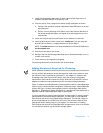Special offers from our partners!

Find Replacement BBQ Parts for 20,308 Models. Repair your BBQ today.

1-4 Dell PowerEdge Cluster FE100 Installation and Troubleshooting Guide
Dell OpenManage™ Managed Node (Data Agent), Dell OpenManage
Application-Transparent Failover (ATF), and Dell OpenManage Data Supervisor or,
if available, Dell OpenManage Data Administrator to manage the PowerVault stor-
age system.
Transmission Control Protocol/Internet Protocol (TCP/IP) running on the LAN.
Currently, NetBIOS Extended User Interface (NetBEUI) and Internetwork Packet
eXchange/Sequenced Packet eXchange (IPX/SPX) are not supported.
%DVLF,QVWDOODWLRQ 3URFHGXUH
This section describes how to configure a cluster with new equipment. For upgrading
existing nonclustered systems to a cluster configuration, see Appendix A, “Upgrading
to a Cluster Configuration.”
NOTE: Before installing the PowerEdge Cluster FE100, ensure that your site power is
adequate to handle the power requirements of the cluster equipment. Contact your
Dell sales representative for information about your region’s power requirements.
If your PowerEdge Cluster FE100 is factory-installed with Windows NT Server, Enter-
prise Edition, then installation in this case involves setting up and cabling the
hardware, setting some configuration options, setting network addresses, and per-
forming functionality checks on the system.
NOTE: Hardware installation should be performed only by trained service technicians.
The following is a comprehensive list of the steps required to install and configure a
PowerEdge Cluster FE100:
1. Add NICs, host bus adapters, PowerEdge Expandable RAID Controllers (optional),
SCSI hard disk drives, Fibre Channel disk drives, and so on to the existing system
hardware to meet the requirements for a PowerEdge Cluster FE100.
2. Cable the system hardware for clustering.
3. Setting up the internal SCSI hard-disk drives.
4. Low-level configuration of the QLogic host bus adapters.
5. Install and configure the Windows NT Server, Enterprise Edition on each node.
6. Configure the public and private NIC interconnects in each node, and place the
interconnects on separate IP subnetworks using static IP addresses.
7. Install the SCSI miniport driver for the QLogic QLA-2100/QLA-2100F host bus
adapters on each node.
8. Install the Windows NT Service Pack 3 and post-Service Pack 3 SCSI hotfix
(scsifixi.exe) or Windows NT Service Pack 4 on each node.
9. Install the device driver for the integrated ATI video controller.
10. Install Dell OpenManage ATF on each node.


















